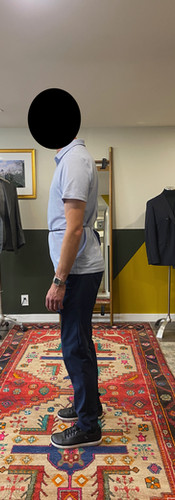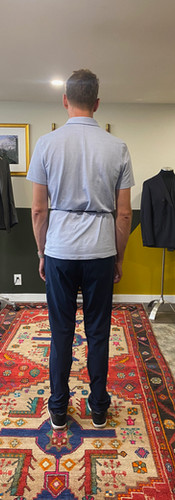How Bespoke Tailoring Solves Posture and Fit Issues: The Subtle Science of Fit
- Allan Sinclair
- Jun 15
- 4 min read
Throughout the life of this journal, you'll see a recurring theme: why bespoke tailoring consistently outperforms factory-made, fast-fashion garments. One of the most fundamental reasons is fit, specifically, how posture plays a critical role in achieving it. In this post, I'll explain why posture matters, how it affects garment balance, and why bespoke tailoring offers the best solution for posture-related fit issues, especially here at Allan David Bespoke in Calgary.
Ready-to-Wear and the Limitations of Standardization
The vast majority of garments sold today are ready-to-wear (RTW), designed to fit the average population. These garments are intended to be quick, easy, and accessible—but they assume perfect symmetry and proportion. Men, with generally fewer physical variations than women, are often lumped into even narrower size categories.
But size and shape are not the same. Two men may wear a 40R, but one might have a sloping shoulder and forward head posture while the other stands upright with square shoulders. In addition to overall size, the distribution of that size plays a crucial role. Two individuals may each measure 40 inches across the chest, yet one may carry more volume in the back while the other carries more volume in the front. This uneven distribution can disrupt the garment's fit, resulting in bunching, strain, and discomfort.
Posture Comparison: How Similar Measurements Can Yield Very Different Fits
The two gentlemen pictured below have similar chest measurements, yet their posture and body shape result in dramatically different fitting needs.
The first gentleman presents with a pronounced forward head posture, rounded upper back, and forward-rolled shoulders. This posture compresses the front of the chest and expands the back, leading to an increased across-back measurement, often larger than what’s typical in ready-to-wear garments. He also has a slightly dropped right shoulder, which is one of the most common asymmetries we see.
In contrast, the second gentleman stands in a more upright position with a prominent chest and retracted shoulders. This results in increased size across the front chest and a narrower back measurement. Notably, he also displays a more pronounced drop shoulder, this time on the left.
Despite having similar numeric measurements on paper, these two postures require entirely different patterning approaches. This is a clear example of how bespoke tailoring accounts for posture, not just size.
That's the key: RTW is made for the hypothetical "average" body, and those garments fall short when your body deviates from the textbook definition of balance such as the ones shown here.
Why Posture Matters in Bespoke Tailoring for Fit and Balance
A dropped right shoulder is one of the most common asymmetries I encounter in my work. Add to that the modern reality of device-driven posture—forward head, rounded back, and forward-thrust shoulders—and it's easy to see why fit issues are so widespread. For jackets, the position of the shoulder and neck determines the entire balance of the garment. If those are off, nothing else will sit correctly.
RTW doesn't accommodate this.
MTM: Real Customization or Just Cosmetic?
Made-to-measure (MTM) suits promise a degree of customization. However, as I explore in detail in our Bespoke vs. Made-to-Measure comparison, MTM offers improvements but is limited compared to bespoke. You can select the fabric, tweak the sleeve or trouser length, or request basic fit alterations. However, you're still working from a base pattern created for someone else's posture, not your own.
That being said, modern MTM manufacturing has undergone considerable improvement in recent years. Some high-end MTM programs now offer adjustments for shoulder slope, posture, and even minor asymmetries. These improvements can provide meaningful benefits if the manufacturer has the capabilities and quality controls.
Our own Made-to-Measure garments, produced in Italy, offer over 80 individual fit adjustments, enabling us to address nuances such as shoulder pitch, sleeve rotation, and back balance. Each garment also features a full floating canvas—a hallmark of quality construction—ensuring greater breathability, shape retention, and overall comfort. Learn more in our guide to floating canvas vs. fused interlinings.
MTM can be an excellent choice for clients with relatively standard proportions, but for those with posture-related asymmetries, bespoke tailoring is still unmatched.
The Bespoke Advantage: Tailored for Your Posture
This is where bespoke tailoring truly shines. Unlike MTM or RTW, bespoke tailoring begins with a pattern crafted from scratch, tailored entirely to your body's unique shape, stance, and posture.
Take me, for example, forward head posture, rounded upper back, forward hips, and a dropped right shoulder. That combination affects every area of fit. If I wore a standard RTW jacket, the collar would likely stand away from my neck, the back would ride up, and the fronts would hang too long. The entire garment would feel off-balance, because it is.
However, with bespoke, these irregularities are built into the pattern. What looks lopsided on a hanger becomes perfectly balanced when worn because it's made for the wearer, not the rack.
This is one of the many aspects I touch on in our Five Fundamentals of Bespoke, which outlines what truly sets bespoke apart.
Final Thought: Fit That Follows Your Form
Most people don't have perfect posture, and that's okay. You don't need to "fix" your body to look good in tailored clothing. You need clothing that's made for your body. That's the beauty of bespoke: it adapts to you, not the other way around.
If you're curious about how bespoke tailoring can solve your posture and fit issues, book a consultation. I'd be happy to walk you through the process and help you decide what approach best suits your needs.










